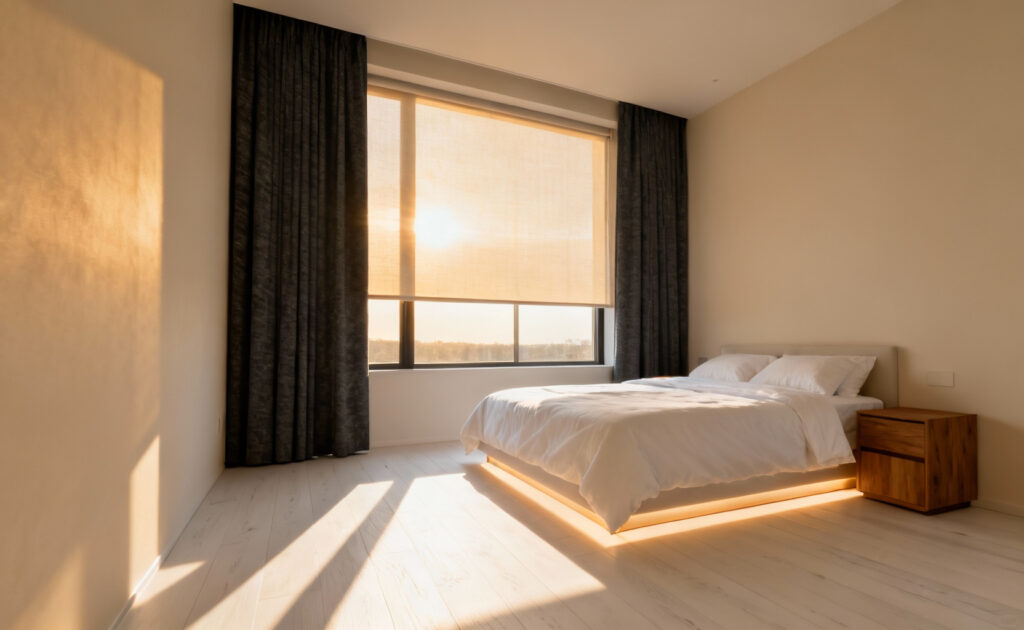Designing a bedroom requires more than selecting a cohesive color palette; it demands an understanding of your body’s innate biology. In my practice as a wellness architect, I prioritize layout choices that stabilize hormone production and sync with natural rhythms. The optimal bedroom furniture layout goes beyond aesthetics; it is a functional tool for health. First, support your circadian rhythm by positioning your bed to capture morning sunlight, while ensuring blackout solutions provide total darkness at night for maximum melatonin release. Next, reduce subconscious anxiety by establishing a “commanding position.” Placing your headboard against a solid wall with a view of the door—but never directly in line with it—signals primal safety to your brain, effectively lowering cortisol levels as you rest.
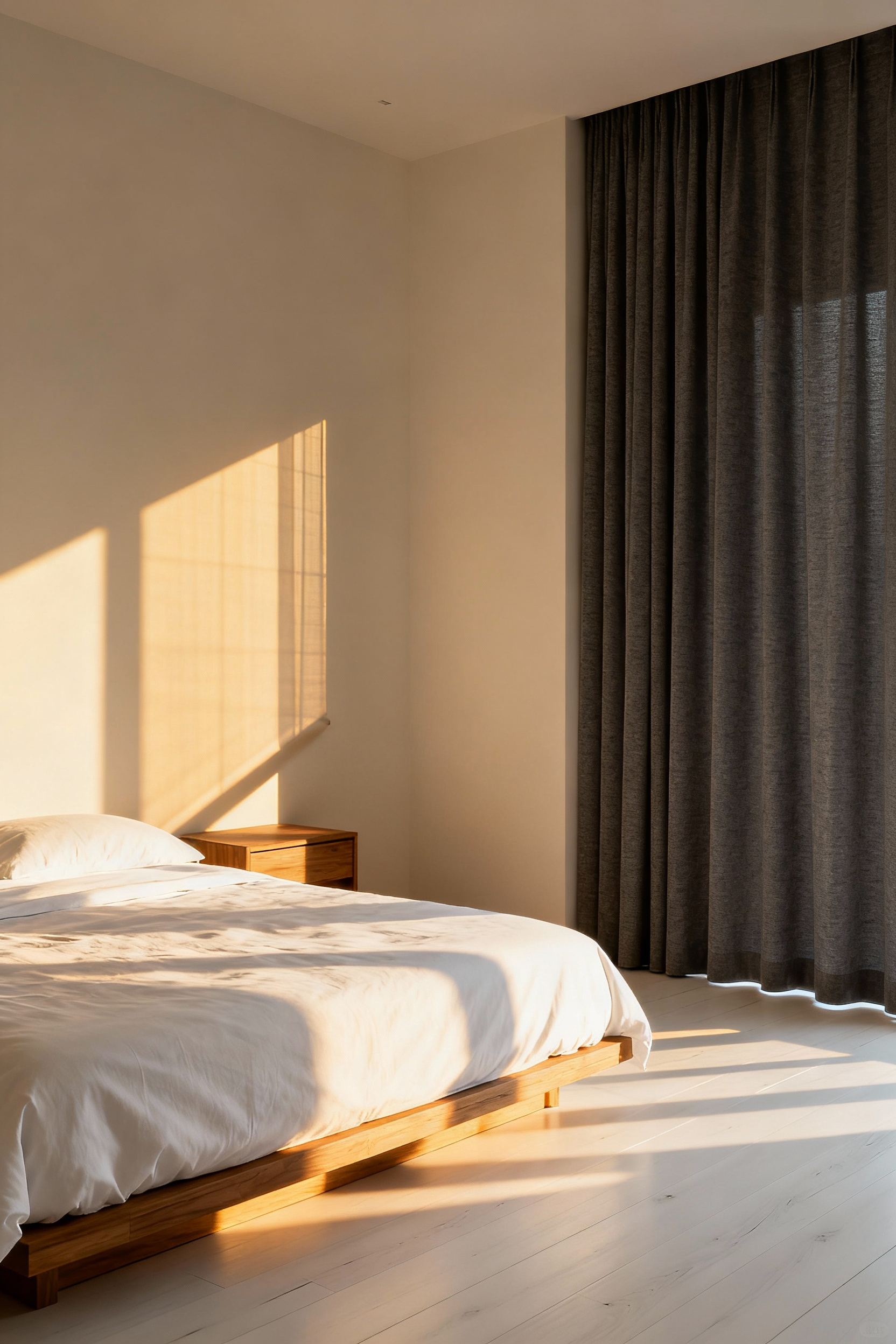
Furthermore, your environment must cultivate “visual calm” to allow your nervous system to settle. Visual clutter stimulates the brain, preventing the necessary wind-down process, so I advise clients to rigorously separate rest from activity. Implement these layout shifts to signal “sleep mode” instantly:
- Ban work zones: Keep desks and electronics out of your direct sightline to break associations with mental alertness.
- Clear the pathways: Maintain at least two feet of open space around the bed to avoid a cramped, stressful atmosphere.
- Contain the chaos: Utilize enclosed storage like dressers to hide visual disorder and quiet the mind.
1. Core Philosophy: Strategic Bedroom Furniture Layout for Sleep Hygiene and Mental Health
Your bedroom communicates directly with your subconscious mind through the principles of environmental psychology. If your layout feels cramped or chaotic, your brain remains in a state of hypervigilance, scanning for threats rather than preparing for deep rest. True sleep hygiene requires a spatial arrangement that signals safety and stability. This begins by adopting the concept of “defensible space,” placing your bed where you can see the door without aligning directly with it. This specific vantage point creates a primal sense of control, allowing your nervous system to downshift effectively from high-alert to relaxation.
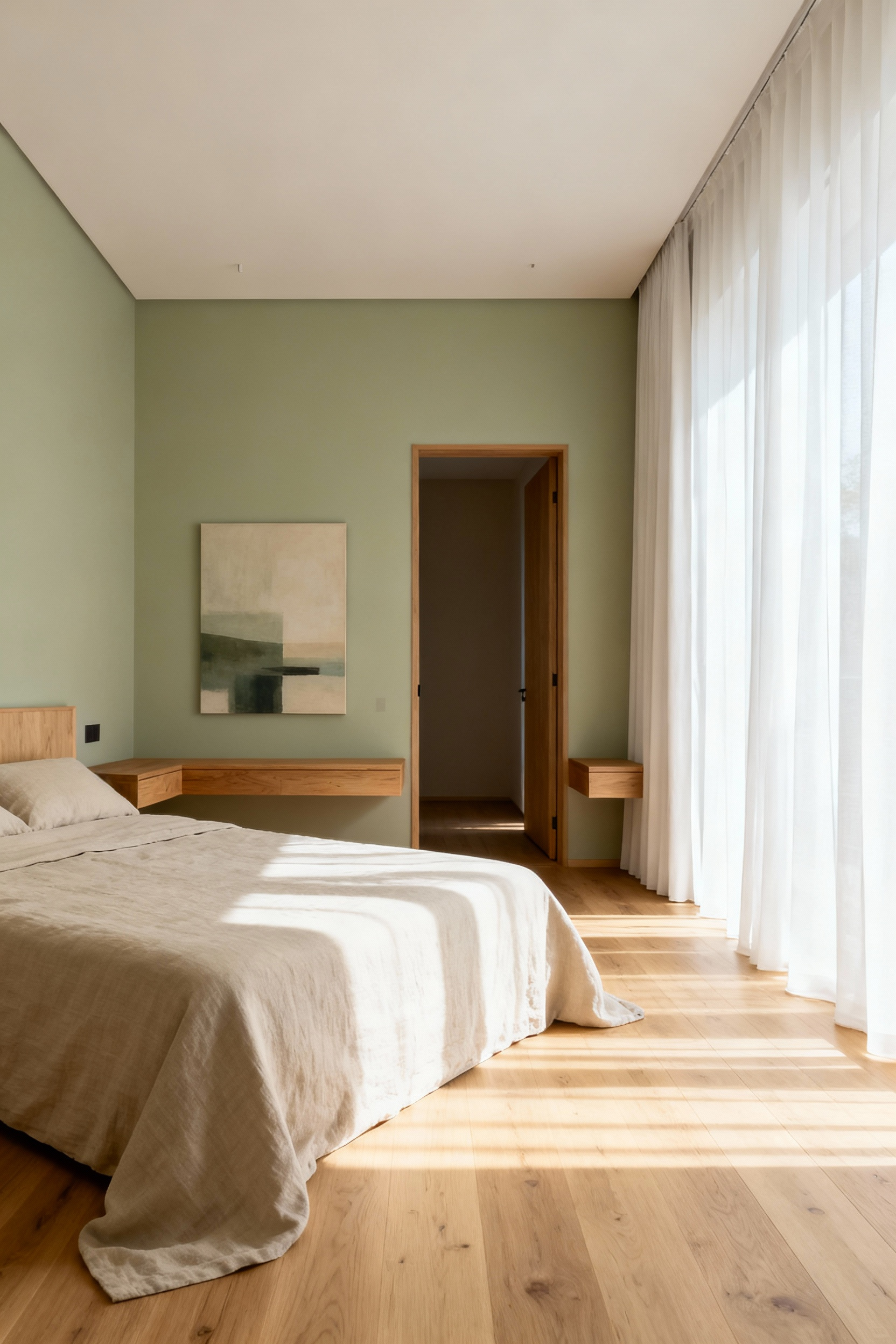
There is often a direct correlation between cluttered pathways and a cluttered mind. To foster emotional balance, you must ensure your layout promotes unobstructed flow and mental clarity. Consider these essential adjustments for a restorative environment:
- Anchor for stability: Place your headboard against a solid wall rather than a window to ground your psychological state.
- Zone for serenity: Remove work desks or exercise gear to teach your brain that this room is strictly a sanctuary.
- Clear the path: Maintain open walkways on both sides of the bed to prevent feelings of confinement.
By physically defining these boundaries, you empower your mind to disconnect from daily stressors and embrace restorative sleep.
2. The Foundation: Establishing the ‘Command Position’ for Nervous System Regulation
Your primal brain constantly scans for danger, preventing deep rest if you feel exposed or vulnerable. To counter this survival instinct, utilize the “Command Position” to create a psychological sanctuary. This layout specifically signals safety to your amygdala, allowing your body to shift into the parasympathetic “rest and digest” state. Start by positioning your bed diagonally across from the door. You must possess a clear view of the entrance without aligning directly with it. Next, anchor your sleep space by placing a solid headboard against a sturdy wall. I prioritize this grounding technique to provide clients with a subconscious sense of unshakeable support.
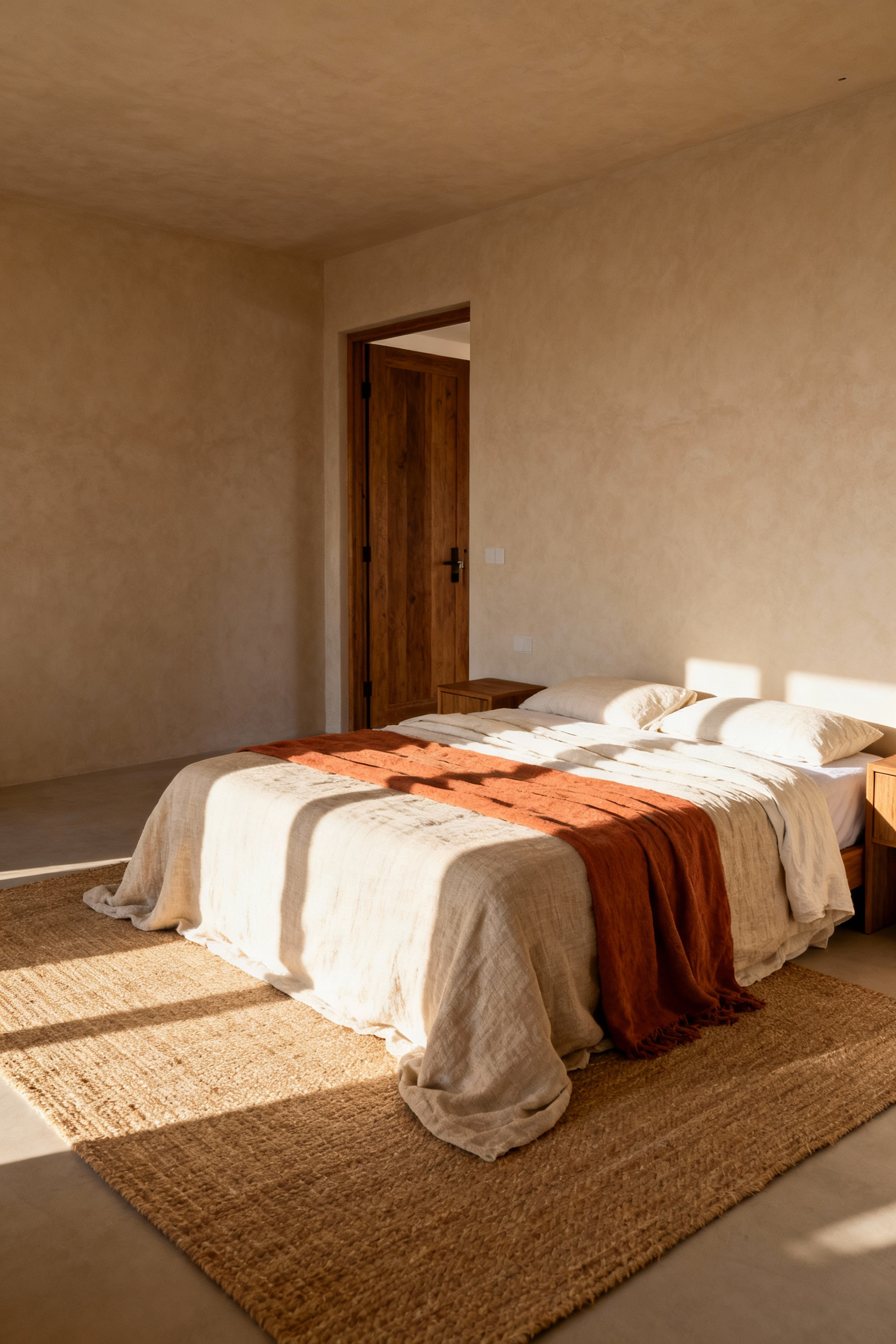
Additionally, eliminate environmental stressors that trigger subtle anxiety. Avoid placing your bed under a window, beneath heavy overhead beams, or in the “coffin position” where your feet point directly out the door. Instead, focus on stability and flow:
- Secure your visual control of the room’s entry points.
- Create balanced access with equal space and matching nightstands on both sides.
- Ensure a solid wall is behind you, rather than open space or glass.
3. Circadian Alignment: Positioning the Bed to Optimize Morning Light Exposure
Your body’s internal clock hinges on consistent light cues. I design bedrooms to harness the sunrise because morning light naturally suppresses melatonin. Position your bed toward an east-facing window to catch those early rays. This orientation signals your brain that sleep is over, helping you wake up feeling alert and energized. If urban light pollution disrupts your sleep, place the bed adjacent to the window rather than directly opposite. Crucially, keep the path clear so you can open the curtains immediately upon waking.
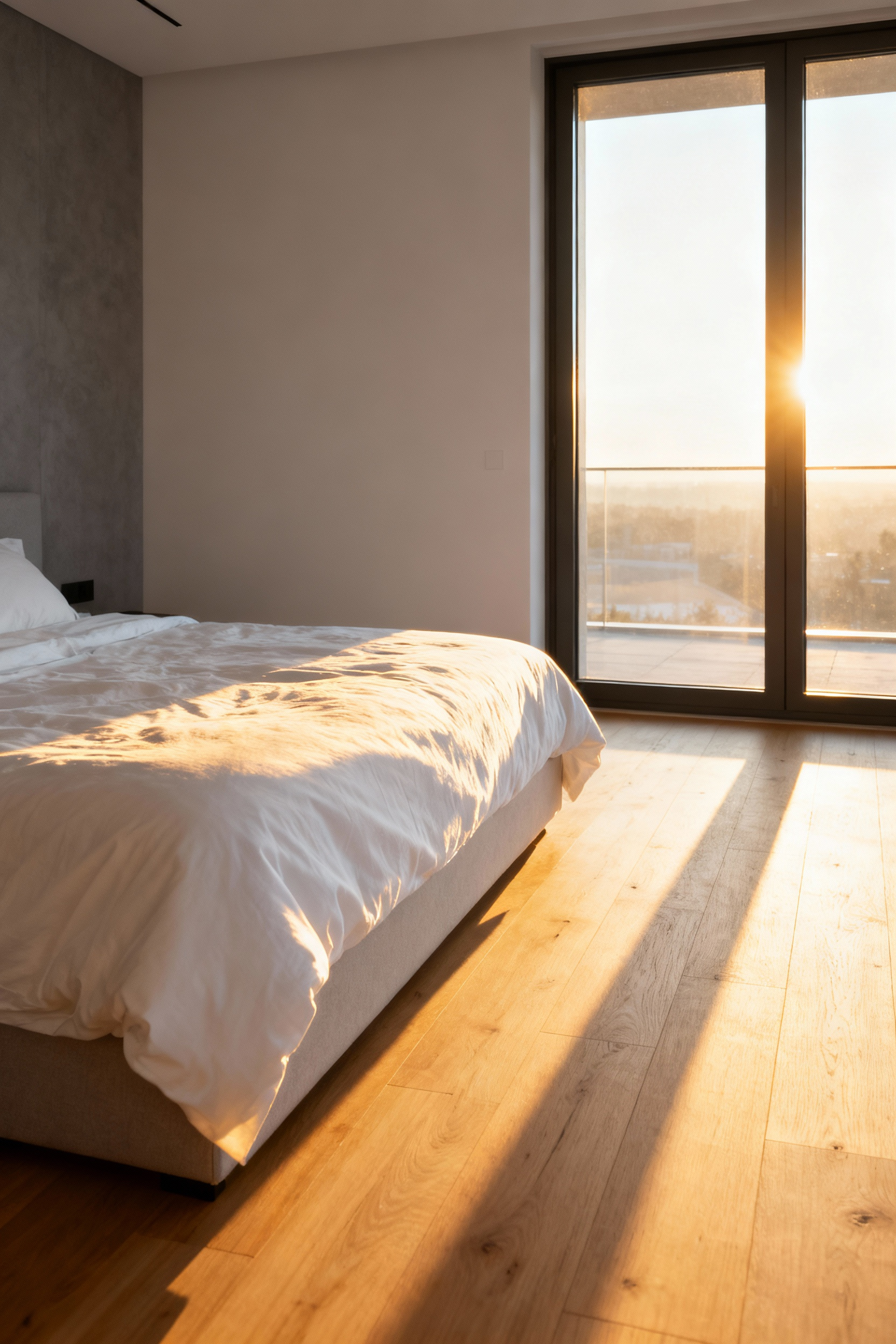
Optimize the intensity of this light with smart decor choices:
- Reflect brightness: Select light-colored walls and furniture to bounce sunlight around the room.
- Control access: Use high-quality blackout blinds to ensure total darkness at night, then open them wide at dawn.
These strategic design moves synchronize your biology with your environment.
4. The Air Gap Principle: Creating ‘Breathing Room’ Around Furniture for Air Quality
Your bedroom furniture needs to breathe so you can too. When you push heavy pieces flush against walls, you inadvertently create “dead zones” that trap dust, moisture, and off-gassing VOCs. Instead, embrace the Air Gap Principle. By pulling furniture just 6 to 12 inches away from the perimeter, you activate the room’s circulatory system and prevent mold-inducing condensation. This “negative space” is vital for optimizing the air quality in your immediate sleep environment.

A slight rearrangement yields profound health benefits. To fully support your home’s ventilation, apply these spacing standards:
- Clear the Vents: Maintain at least one foot of clearance around radiators, windows, and air returns to maximize HVAC efficiency.
- Open the Back: Ensure a gap behind wardrobes and headboards to disperse stale air pockets.
Furthermore, this layout facilitates easier cleaning. You can swiftly vacuum away hidden allergens and pet dander behind heavy items, ensuring your sanctuary remains truly restorative.
5. Intentional Symmetry: Balancing Nightstands to Soothe the Visual Cortex
Your brain constantly scans the environment for patterns to ensure safety. Intentional symmetry satisfies this need, acting as a balm for the visual cortex and significantly reducing cognitive load. A balanced layout signals stability to the nervous system, allowing for deeper rest. Prioritize a consistent “horizon line” by ensuring nightstand tops sit level with or slightly above the mattress to create a soothing, unbroken visual plane.
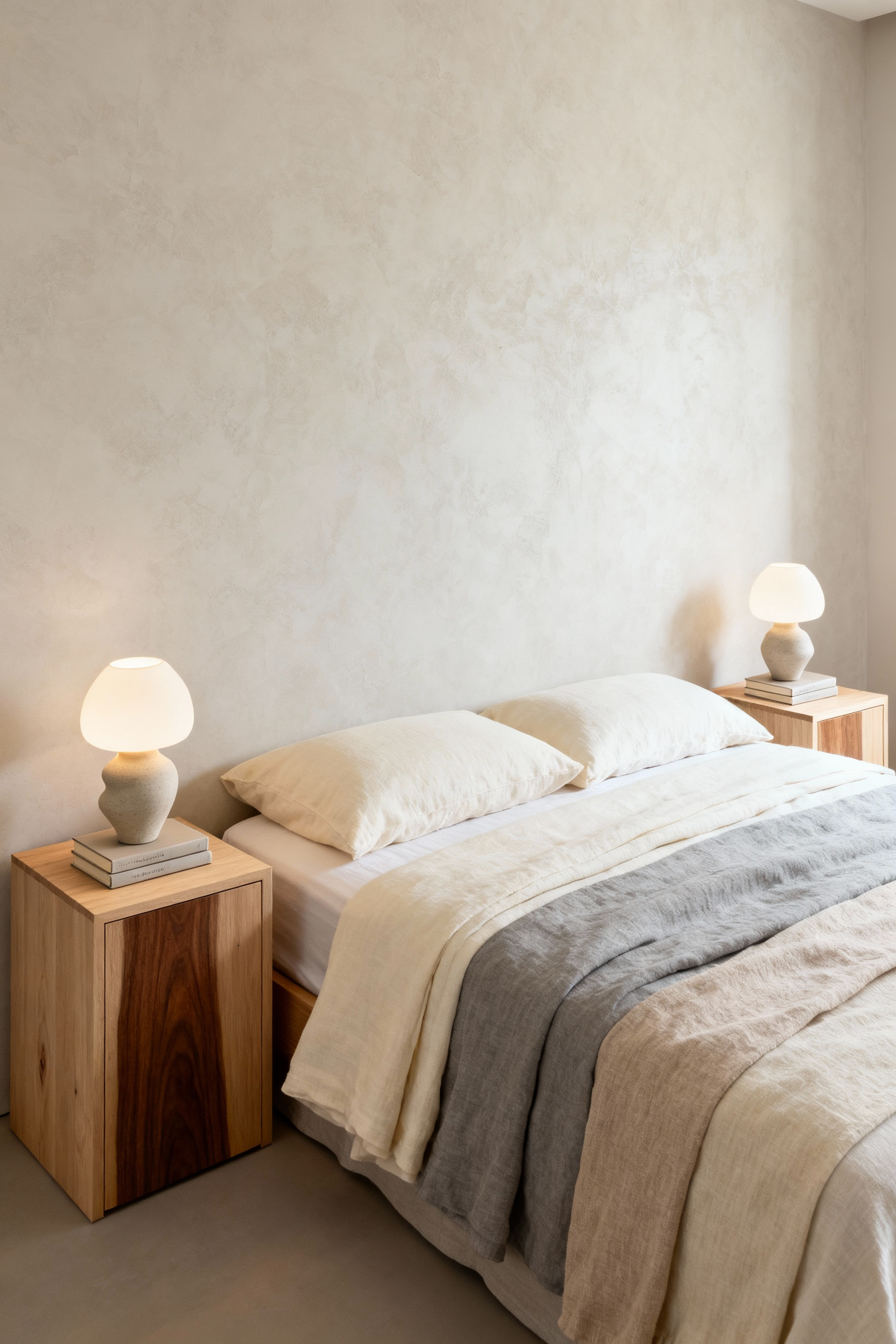
However, perfect duplication is not required for tranquility. You can achieve “visual weight” balance with mismatched pieces by adhering to three simple principles:
- Match the Scale: Pair furniture of similar width and depth to avoid a lopsided feel.
- Anchor with Light: Use identical lamps on both sides to re-establish the central axis.
- Layer the Heights: Vary accessory sizes to add depth without breaking the symmetrical frame.
By curating this balance, you actively engineer a space that helps your mind unwind.
6. Intermediate Layering: Balancing Visual Weight with Dressers and Wardrobes
Think of intermediate layering as the emotional stabilizer of your bedroom. Your brain naturally seeks “cognitive ease,” meaning environments that are easy to process visually reduce mental fatigue. Dressers and wardrobes serve as this critical bridge between your grounding bed and delicate decor. However, too much bulk creates visual stress. To cultivate flow, vary your vertical planes. Place a tall wardrobe on one wall, then counterbalance it with a low, sleek console on another. This height variation adds dimension without overwhelming your senses. Avoid the rigid “catalog look”; if your bed frame features dark wood, select a painted or medium-tone dresser. Distinct, complementary textures create a curated, organic feel that supports deep rest.

I recall a client who felt perpetually cramped in her large bedroom, despite having ample square footage. The culprit was a solid, heavy dresser that blocked the room’s energy flow. We swapped it for a piece with open legs, immediately making the space feel breathable and expansive. To master this visual balance yourself:
- Anchor asymmetrically: Offset a heavy wardrobe with a grouping of airy plants or a large floor mirror on the opposite side.
- Lighten the load: Choose high-gloss finishes or light tones to reflect natural light rather than absorb it.
- Utilize architecture: Slide storage into alcoves to create a seamless, built-in effect that recedes from the eye.
7. The ‘Uncluttered Pathway’: Designing Traffic Flow to Lower Cortisol Levels
Your nervous system constantly scans your environment for safety. When you navigate awkward furniture layouts or step over clutter, your brain registers a micro-stressor. This subtle friction elevates cortisol levels and prevents deep relaxation. Physical blockages in a room often manifest as mental tension. To heal this, prioritize the “Primary Movement Zone”—the direct line from your door to your bed. Keep this route completely clear to signal immediate safety to your subconscious mind.
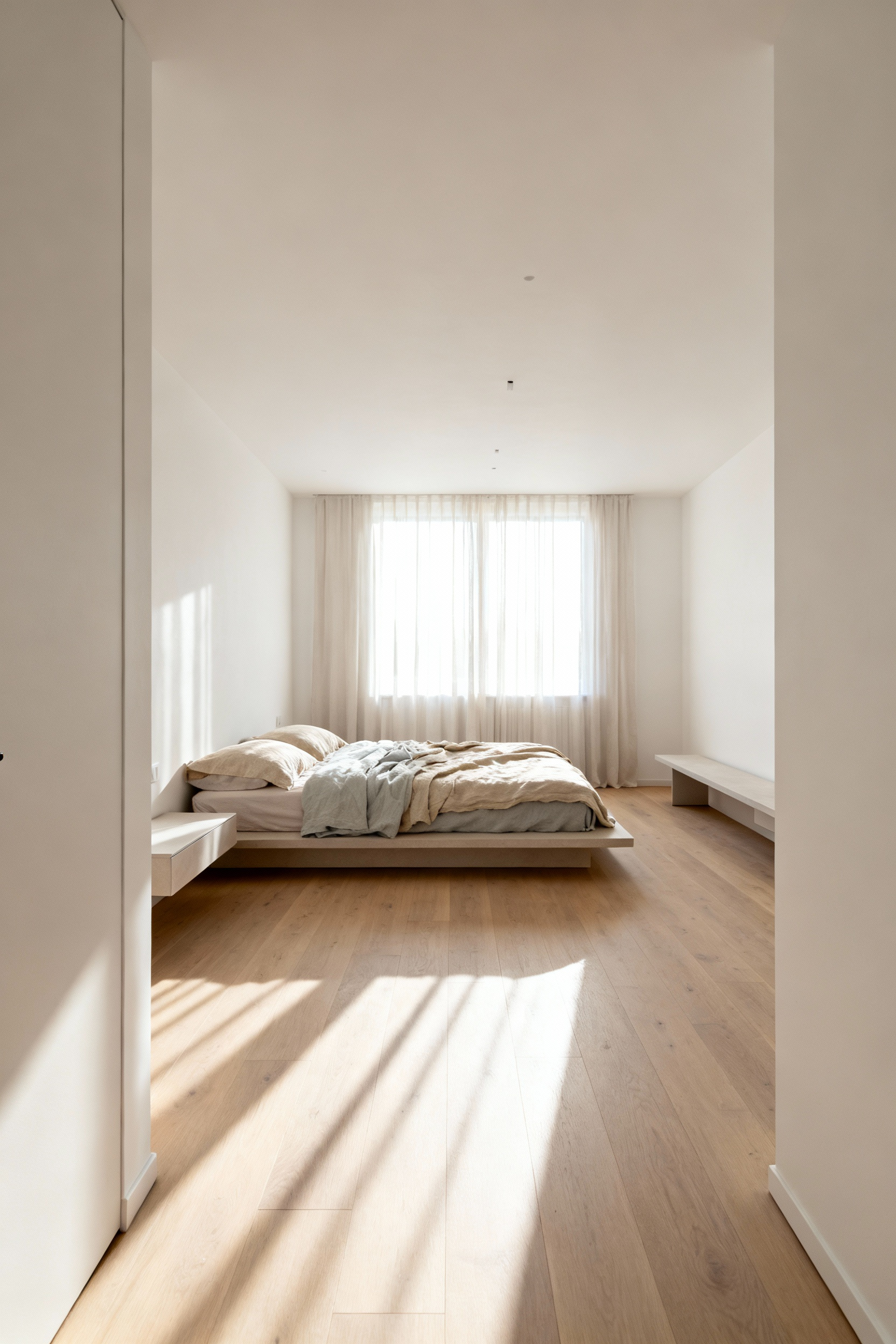
Precision creates peace. Establish a minimum 3-foot (90 cm) pathway around your bed and towards the closet to prevent the subconscious need to brace for impact. Furthermore, soften the journey with intentional design choices:
- Select furniture with rounded edges to prevent jarring bumps and irritation.
- Utilize beds with integrated drawers to remove visual obstacles from the floor.
- Position the bed to view the door without being in direct alignment for optimal feelings of control.
These adjustments transform your bedroom from a stressful obstacle course into a fluid, restorative sanctuary.
8. Strategic Reflection: Placing Mirrors to Enhance Light Without Creating Visual Noise
Mirrors act as powerful amplifiers of natural light, serving as “light nutrients” for your space rather than mere decorative objects. To maximize this benefit, position a large, frameless mirror directly opposite a window; this instantly doubles the distribution of daylight and creates the illusion of expansive architecture. However, you must strictly apply the core rule of strategic reflection: capture scenery, not clutter. A mirror facing a disorganized corner simply doubles the visual chaos and increases your brain’s cognitive load. Instead, angle your glass to catch outdoor greenery or a calming piece of art to bring nature deeper into your sanctuary.

I frequently steer clients away from the common mistake of positioning mirrors directly across from the bed. Evolutionarily, the human brain remains alert to movement, so reflecting shifting shadows or your own silhouette at night can trigger micro-awakenings and disturb deep REM cycles. To maintain a restorative environment, follow these wellness-driven guidelines:
- Prioritize Scale: Choose one large leaner mirror over a cluster of small ones to reduce visual fragmentation and busyness.
- Soften the Glow: Select antique or smoked glass if the window reflection feels too harsh or glaring.
- Respect the Bed: Position mirrors on side walls or behind lamps to enhance ambient warmth without creating sleep-disrupting distractions.
9. The Digital Detox Perimeter: Layout Strategies That Physically Block Blue Light
Your bedroom layout should actively defend your circadian rhythm. Build a “Digital Detox Perimeter” that physically obstructs stimulating blue light. Do not rely on willpower alone; let your furniture support your sleep hygiene. Start by upgrading to nightstands with internal charging stations. By securing your phone inside a closed drawer, you completely block notification blinks without banishing the device from the room.
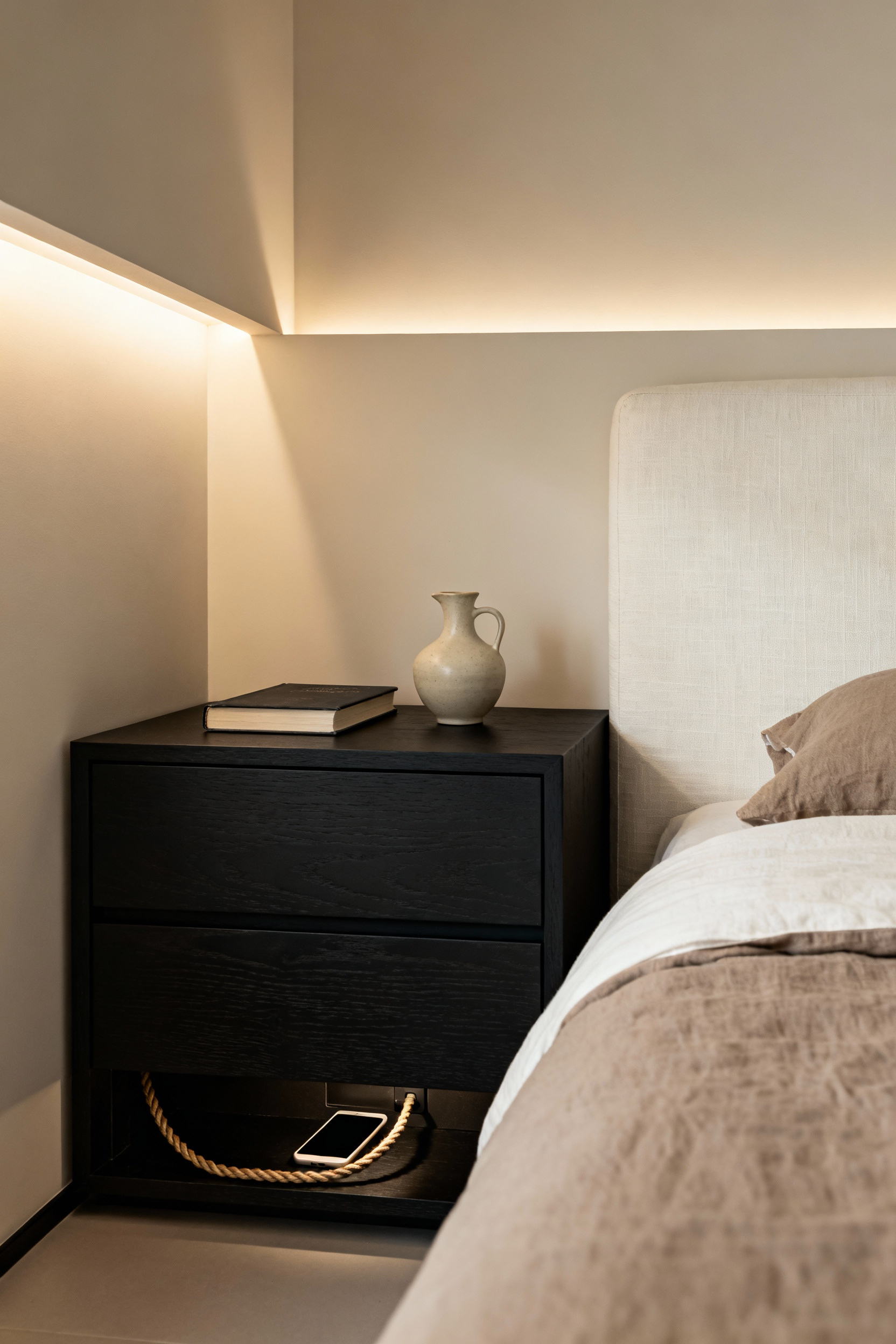
Similarly, ensure larger screens vanish when the day ends. Consider these physical barriers to reclaim your sanctuary:
- Conceal Screens: Tuck televisions inside an armoire or utilize a motorized lift to hide the glass when not in use.
- Disrupt Sightlines: Position tall wardrobes or decorative screens as visual baffles to block the view of blinking routers or work desks.
These solid obstacles break the line of sight between your pillow and the glow, allowing your mind to truly unwind.
10. Advanced Application: Creating a ‘Pause Point’ or Meditation Nook
Our nervous systems constantly respond to environmental cues. A dedicated “Pause Point” creates a vital buffer between daily stress and restorative sleep. Even three square feet of intentional space can lower cortisol levels significantly. Begin by grounding a sunny corner or unused niche with a soft area rug or layered blanket. This textural shift physically defines the zone and instantly signals your brain to switch modes.
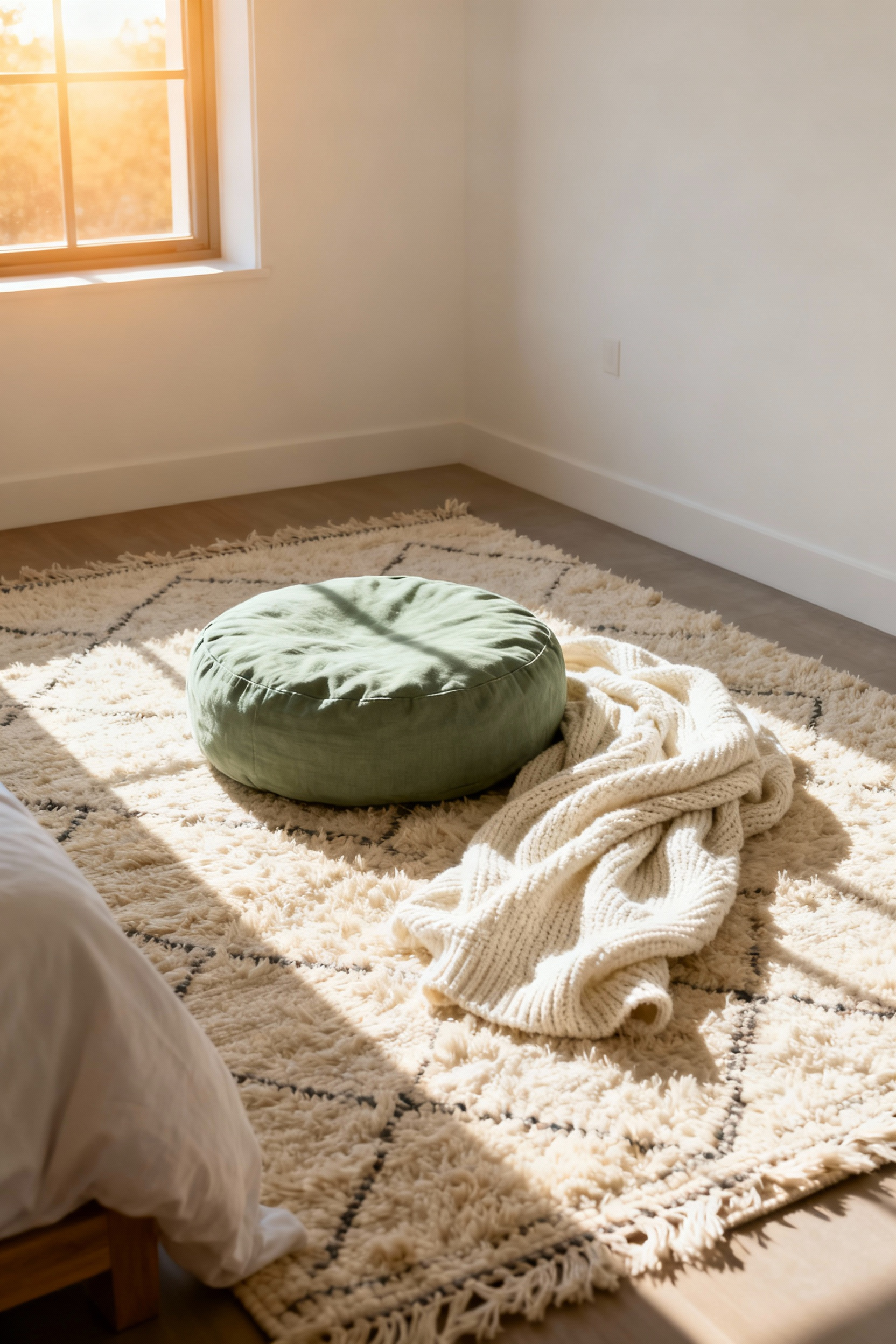
Next, establish a sense of privacy to deepen your focus. Strategically position a tall floor plant or folding screen to visually separate this sanctuary from your sleeping area. Keep the furnishings purposeful to maintain energetic flow:
- Choose a low-profile cushion or lightweight chair that tucks away easily.
- Incorporate a small side table to serve as a simple altar for a candle or journal.
- Maintain a clutter-free floor to reduce visual noise.
By physically defining this boundary, you empower your mind to embrace stillness efficiently.
11. Biophilic Integration: Positioning Plants for Maximum Oxygenation and Stress Reduction
Transform your bedroom into a regenerative sanctuary by strategically positioning plants for metabolic health. Too often, greenery is placed too far from where we breathe. Correct this by moving night-time oxygen producers, such as Snake Plants or Aloe Vera, directly onto your nightstand. Keeping these varieties within four feet of your pillow maximizes oxygen intake while you sleep. This immediate proximity does more than purify the air; it establishes a subconscious biological connection that actively lowers cortisol levels and promotes deeper rest.
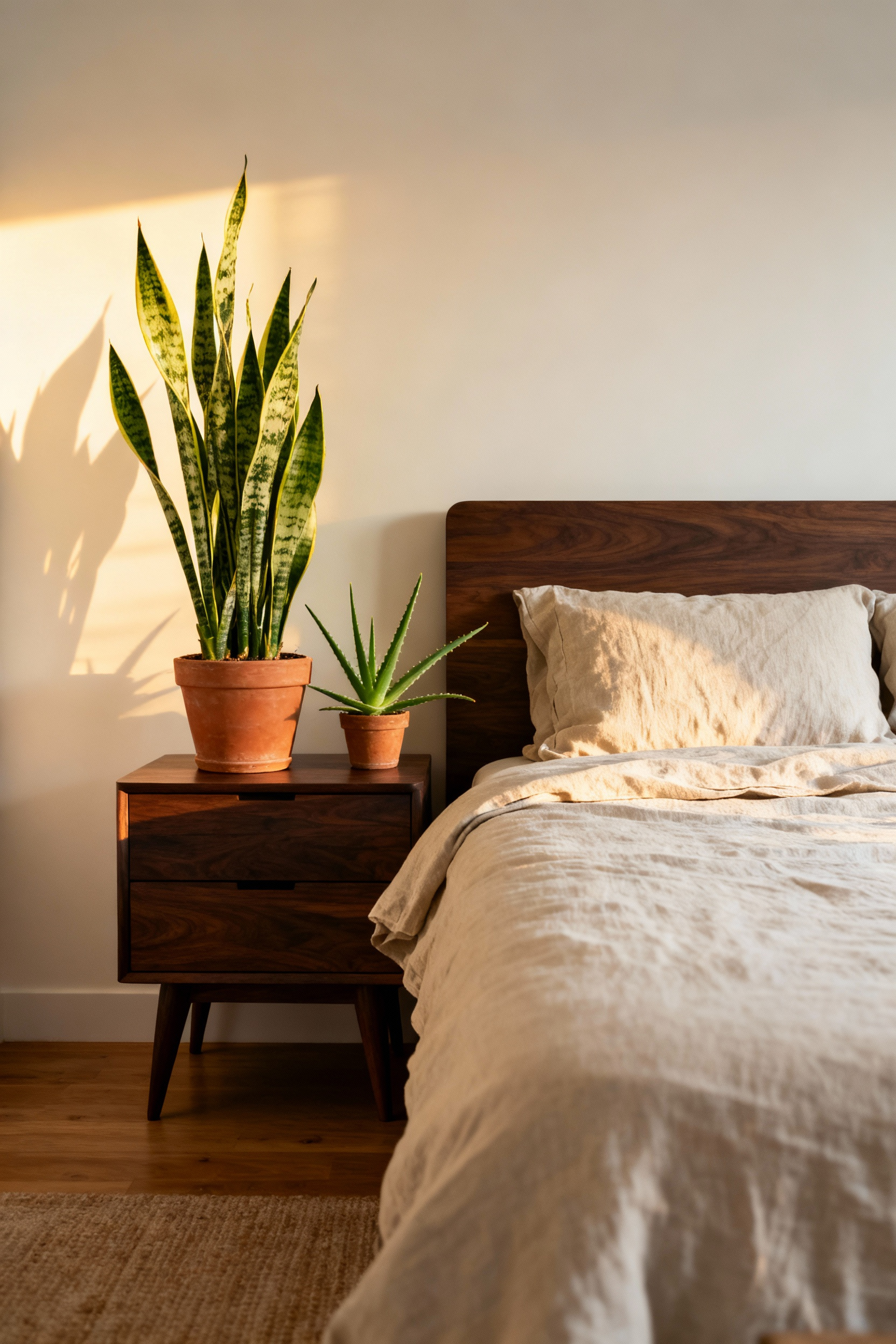
Optimize your remaining layout to support both plant health and visual calm. Do not block natural light sources with heavy dressers; instead, arrange furniture to frame windows, ensuring your photosynthetic allies thrive. For smaller rooms, utilize vertical space to layer nature into the design:
- Go Vertical: Place trailing Pothos on high shelves or tall bookcases to draw the eye upward without consuming floor space.
- Anchor Corners: Fill empty voids next to wardrobes with a large Areca Palm to boost humidity and reduce visual noise.
By intentionally curating these “green zones,” you turn static furniture layouts into living, breathing ecosystems that support your well-being.
12. Tactile Grounding: Rug Placement Rules for Sensory Comfort
Your feet contain thousands of nerve endings that send immediate signals to your brain upon contact with the ground. Stepping onto a cold, hard floor triggers a micro-stress response before your day even begins. Counteract this by prioritizing a “soft landing.” Select a high-pile or plush rug and position it perpendicular to the bed. Ensure the material extends 18 to 24 inches beyond the mattress sides. This specific placement guarantees your first tactile experience is one of warmth, effectively soothing your nervous system.
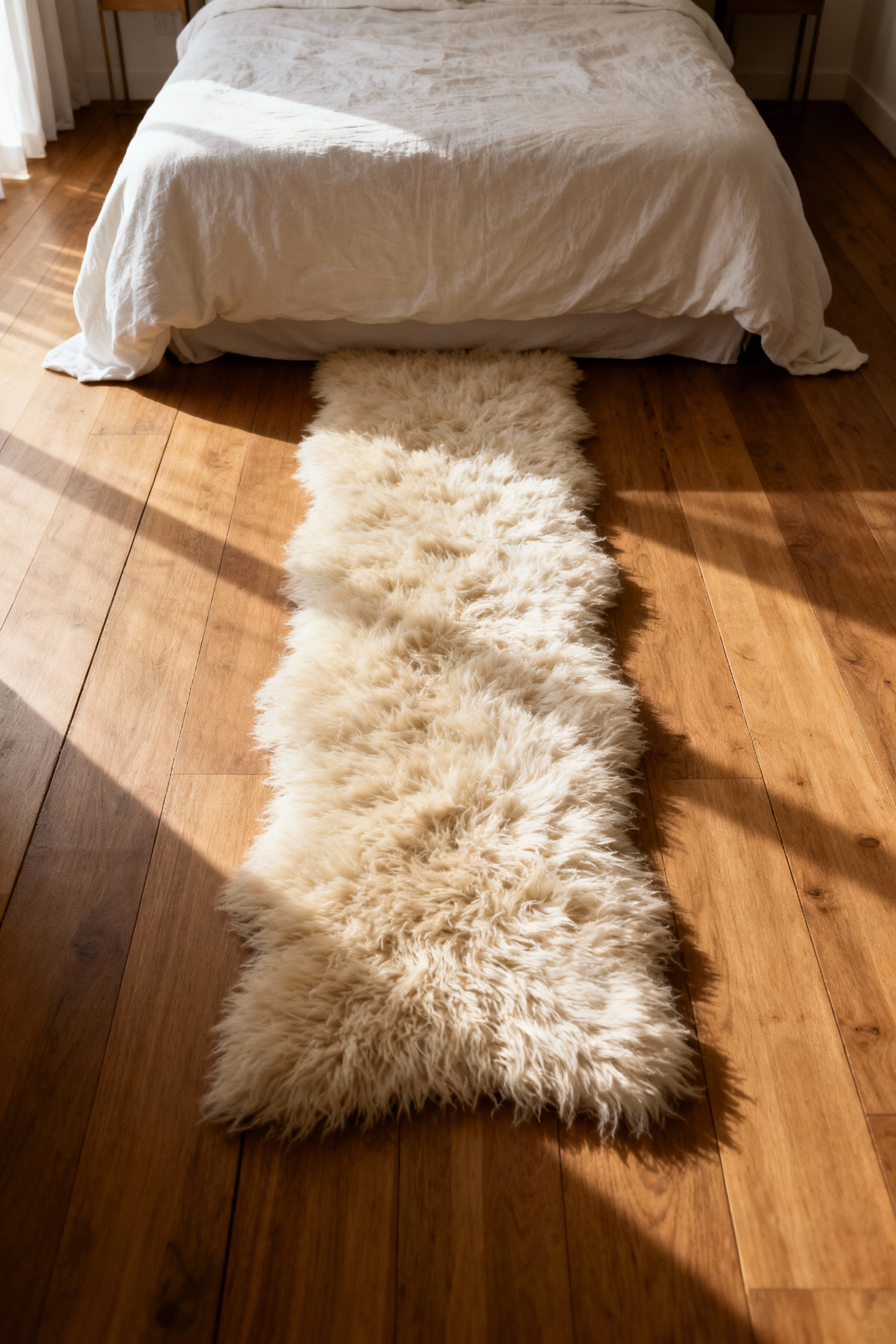
Extend this sensory grounding beyond the bedside. Treat texture as a functional tool for emotional regulation by creating distinct zones:
- Anchor the Bed: Start the main rug just in front of your nightstands to visually define the sleep zone.
- Support Rituals: Place a soft runner near the closet or vanity to cushion your joints during morning routines.
- Layer for Depth: Add a small sheepskin over a flat-weave rug in a reading nook to double the tactile comfort.
Intentional placement transforms your floor from a simple surface into a restorative tool for your body.
13. EMF Awareness: Safe Distances Between Sleep Zones and Electrical Outlets
As a wellness architect, I treat the bedroom as a sanctuary for cellular repair, yet invisible electromagnetic fields (EMFs) often disrupt this delicate process. To protect your sleep quality, distance is your best defense. Position your headboard at least 3 to 6 feet away from active electrical outlets and power strips. Additionally, pull your bed frame roughly 8 inches away from the wall. This simple gap minimizes exposure to magnetic fields radiating from the electrical wiring hidden behind the drywall.

Next, ruthlessly declutter your nightstand of electronic noise. Devices plugged into the wall emit EMFs even on standby, so unplug anything non-essential. To create a truly restorative low-EMF zone:
- Relocate cell phone chargers and Wi-Fi routers to another room.
- Replace electric alarm clocks with battery-operated analog versions.
- Keep lamps at arm’s length rather than right beside your head.
By curating this electrical silence, you empower your body to rest deeply without interference.
14. Mastery Integration: The ‘Morning View’ Concept—Orienting Layouts for Positive Waking Psychology
Your first visual impression upon waking sets the emotional trajectory for your entire day. We utilize “Positive Waking Psychology” to harness this moment for mental clarity. Position your bed so your eyes immediately land on a source of inspiration, such as a nature-filled window or a piece of calming art. This alignment invites morning sunlight to naturally regulate your circadian rhythm and boost your mood before your feet even touch the floor.

To deepen this effect, create a layout that balances visual stimulation with primal safety. Establish a “Mastery Integration” zone using these specific adjustments:
- Anchor the headboard against a solid wall to satisfy the psychological need for security while facing the view.
- Filter the light with sheer curtains to soften the morning sun without blocking its energizing benefits.
- Place a comfortable chair near the window to create a dedicated nook for a transition ritual, like journaling or enjoying a quiet coffee.
By intentionally curating this morning view, you transform your bedroom from a simple sleeping space into a launchpad for a productive, happy day.
15. The Flow State: Ensuring Chi (Energy) Moves Freely Around the Bed Frame
In my practice combining interior design with wellness architecture, I view the bed not just as furniture, but as a recharging station. For this station to function, *Chi*—or life force energy—must circulate freely around your body like a gentle current. Think of this flow like air circulation; physical blockages create energetic stagnation. Therefore, select a bed frame elevated off the floor and position it to allow open access on both sides. Pushing a mattress against a wall restricts movement and disrupts the equilibrium necessary for deep, restorative sleep.
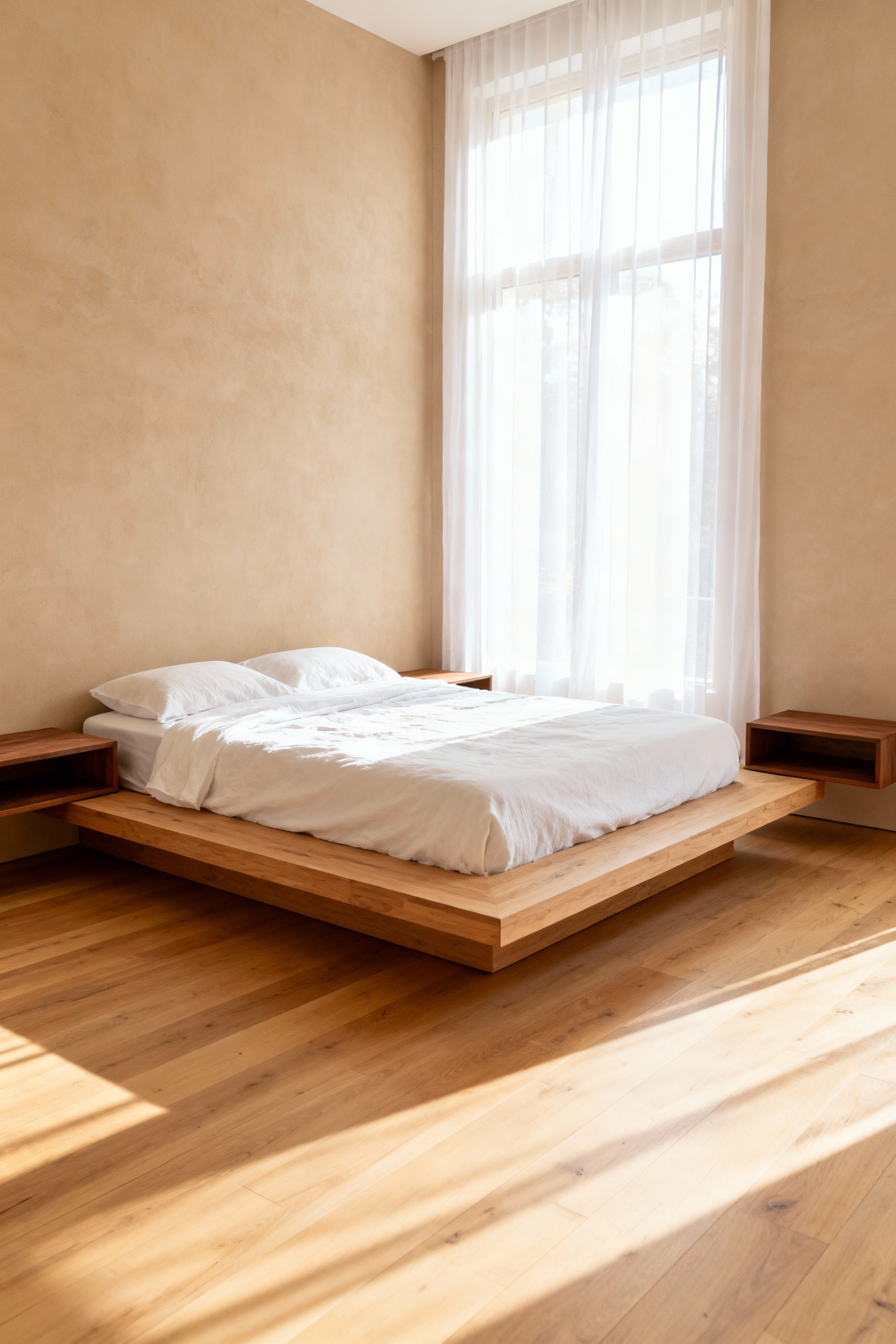
To fully unlock this flow state, you must address what lies beneath and beside you. Clear all storage from under the bed immediately, as clutter here traps dust and stagnant energy, often making you feel subconsciously “stuck.” Once cleared, anchor the room with intention using these principles:
- Establish Symmetry: Use matching nightstands to promote equality and balanced energy.
- Soften Edges: Choose furniture with rounded corners to prevent the harshness of sharp angles.
- Maximize Clearance: Keep the floor visible to allow energy to wash over the entire space.
These simple shifts remove invisible barriers, inviting a harmonious rhythm back into your rest.
Frequently Asked Questions About Bedroom Furniture Layout
What is the ideal placement for a bed to maximize deep sleep?
The ideal placement for a bed, often called the “Command Position,” is diagonally across from the door. This allows you to see the room’s entrance without being directly aligned with it, which subconsciously signals safety and control to your nervous system, promoting deeper, more restorative sleep.
How much space should I leave around my bedroom furniture?
You should aim for at least 3 feet (90 cm) of clearance for primary traffic paths (the line from the door to the bed or closet). For secondary items like dressers and heavy wardrobes, ensure you maintain an “Air Gap” of 6 to 12 inches away from the wall to prevent mold and optimize air circulation.
Where is the best place to put a dresser or wardrobe in a small bedroom?
In small bedrooms, utilize vertical layering. Place tall wardrobes against the longest, solid wall to serve as a visual anchor, and balance this height with low-profile dressers on opposing walls. If space is tight, consider placing the dresser inside the closet or using sleek, floating drawers to keep the floor clear and minimize clutter.
Should I position a mirror opposite my bed in the bedroom?
No. While mirrors help amplify light when placed opposite a window, positioning a mirror directly across from the bed can disrupt deep sleep. Reflecting shadows or your own moving image at night can trigger micro-awakenings, as your brain registers movement and stays alert. Place mirrors on side walls instead.
Conclusion: Mastering Your Bedroom Furniture Layout to Create a Restorative Sanctuary
True restoration requires a bedroom that actively lowers your cortisol levels. I see firsthand how visual noise disrupts the nervous system, so you must prioritize a layout that fosters calm. Start by positioning a low-profile bed as your grounded focal point. Then, aggressively eliminate visible clutter by utilizing hidden storage benches or deep drawers. Keeping reminders of daily tasks out of sight allows your mind to switch off the moment you cross the threshold.

Refine your furniture arrangement to support healthy sleep hygiene by adopting specific zoning techniques to separate “winding down” from actual sleeping:
- Enforce the Minimalist Nightstand Rule: Keep surfaces clear of stimulating gadgets, leaving only calming essentials like a book or aromatherapy.
- Designate a Soft Zone: If space permits, place a plush chair away from the bed for reading or quiet reflection.
This physical separation trains your brain to associate the bed exclusively with deep rest. By intentionally curating your bedroom furniture layout, you transform four walls into a powerful vessel for healing.
